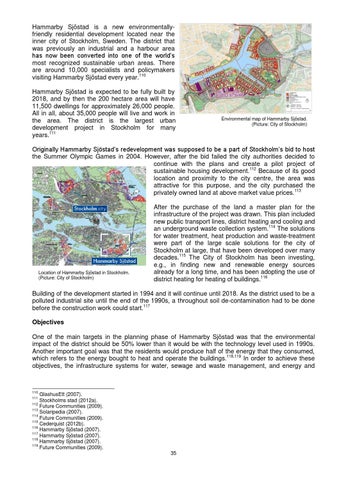Hammarby Sjöstad is a new environmentallyfriendly residential development located near the inner city of Stockholm, Sweden. The district that was previously an industrial and a harbour area has now been converted into one of the world’s most recognized sustainable urban areas. There are around 10,000 specialists and policymakers visiting Hammarby Sjöstad every year.110 Hammarby Sjöstad is expected to be fully built by 2018, and by then the 200 hectare area will have 11,500 dwellings for approximately 26,000 people. All in all, about 35,000 people will live and work in the area. The district is the largest urban development project in Stockholm for many years.111
Environmental map of Hammarby Sjöstad. (Picture: City of Stockholm)
Originally Hammarby Sjöstad’s redevelopment was supposed to be a part of Stockholm’s bid to host the Summer Olympic Games in 2004. However, after the bid failed the city authorities decided to continue with the plans and create a pilot project of sustainable housing development.112 Because of its good location and proximity to the city centre, the area was attractive for this purpose, and the city purchased the privately owned land at above market value prices.113
Location of Hammarby Sjöstad in Stockholm. (Picture: City of Stockholm)
After the purchase of the land a master plan for the infrastructure of the project was drawn. This plan included new public transport lines, district heating and cooling and an underground waste collection system.114 The solutions for water treatment, heat production and waste-treatment were part of the large scale solutions for the city of Stockholm at large, that have been developed over many decades.115 The City of Stockholm has been investing, e.g., in finding new and renewable energy sources already for a long time, and has been adopting the use of district heating for heating of buildings.116
Building of the development started in 1994 and it will continue until 2018. As the district used to be a polluted industrial site until the end of the 1990s, a throughout soil de-contamination had to be done before the construction work could start.117 Objectives One of the main targets in the planning phase of Hammarby Sjöstad was that the environmental impact of the district should be 50% lower than it would be with the technology level used in 1990s. Another important goal was that the residents would produce half of the energy that they consumed, which refers to the energy bought to heat and operate the buildings.118,119 In order to achieve these objectives, the infrastructure systems for water, sewage and waste management, and energy and
110
GlashusEtt (2007). Stockholms stad (2012a). 112 Future Communities (2009). 113 Solaripedia (2007). 114 Future Communities (2009). 115 Cederquist (2012b). 116 Hammarby Sjöstad (2007). 117 Hammarby Sjöstad (2007). 118 Hammarby Sjöstad (2007). 119 Future Communities (2009). 111
35
